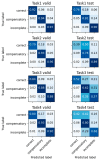Application of Deep Learning Algorithm to Monitor Upper Extremity Task Practice
- PMID: 37447958
- PMCID: PMC10346825
- DOI: 10.3390/s23136110
Application of Deep Learning Algorithm to Monitor Upper Extremity Task Practice
Abstract
Upper extremity hemiplegia is a serious problem affecting the lives of many people post-stroke. Motor recovery requires high repetitions and quality of task-specific practice. Sufficient practice cannot be completed during therapy sessions, requiring patients to perform additional task practices at home on their own. Adherence to and quality of these home task practices are often limited, which is likely a factor reducing rehabilitation effectiveness post-stroke. However, home adherence is typically measured by self-reports that are known to be inconsistent with objective measurement. The objective of this study was to develop algorithms to enable the objective identification of task type and quality. Twenty neurotypical participants wore an IMU sensor on the wrist and performed four representative tasks in prescribed fashions that mimicked correct, compensatory, and incomplete movement qualities typically seen in stroke survivors. LSTM classifiers were trained to identify the task being performed and its movement quality. Our models achieved an accuracy of 90.8% for task identification and 84.9%, 81.1%, 58.4%, and 73.2% for movement quality classification for the four tasks for unseen participants. The results warrant further investigation to determine the classification performance for stroke survivors and if quantity and quality feedback from objective monitoring facilitates effective task practice at home, thereby improving motor recovery.
Keywords: accelerometer; deep learning; inertial measurement unit (IMU); machine learning; rehabilitation; stroke; upper extremity; wearable sensor.
Conflict of interest statement
The authors declare no conflict of interest. The funders had no role in the design of the study; in the collection, analyses, or interpretation of data; in the writing of the manuscript; or in the decision to publish the results.
Figures





Similar articles
-
Wearable Sensor to Monitor Quality of Upper Limb Task Practice for Stroke Survivors at Home.Sensors (Basel). 2024 Jan 16;24(2):554. doi: 10.3390/s24020554. Sensors (Basel). 2024. PMID: 38257646 Free PMC article.
-
Monitoring Arm Movements Post-Stroke for Applications in Rehabilitation and Home Settings.IEEE Trans Neural Syst Rehabil Eng. 2022;30:2312-2321. doi: 10.1109/TNSRE.2022.3197993. Epub 2022 Aug 22. IEEE Trans Neural Syst Rehabil Eng. 2022. PMID: 35947559
-
Detecting compensatory movements of stroke survivors using pressure distribution data and machine learning algorithms.J Neuroeng Rehabil. 2019 Nov 4;16(1):131. doi: 10.1186/s12984-019-0609-6. J Neuroeng Rehabil. 2019. PMID: 31684970 Free PMC article.
-
Task selection for a sensor-based, wearable, upper limb training device for stroke survivors: a multi-stage approach.Disabil Rehabil. 2023 May;45(9):1480-1487. doi: 10.1080/09638288.2022.2065542. Epub 2022 Apr 27. Disabil Rehabil. 2023. PMID: 35476616 Review.
-
The Effect of Priming on Outcomes of Task-Oriented Training for the Upper Extremity in Chronic Stroke: A Systematic Review and Meta-analysis.Neurorehabil Neural Repair. 2020 Jun;34(6):479-504. doi: 10.1177/1545968320912760. Epub 2020 May 26. Neurorehabil Neural Repair. 2020. PMID: 32452242
Cited by
-
Advanced Home-Based Shoulder Rehabilitation: A Systematic Review of Remote Monitoring Devices and Their Therapeutic Efficacy.Sensors (Basel). 2024 May 5;24(9):2936. doi: 10.3390/s24092936. Sensors (Basel). 2024. PMID: 38733040 Free PMC article.
-
The Use of TheraBracelet Upper Extremity Vibrotactile Stimulation in a Child with Cerebral Palsy-A Case Report.Electronics (Basel). 2024 Aug 2;13(16):3147. doi: 10.3390/electronics13163147. Epub 2024 Aug 9. Electronics (Basel). 2024. PMID: 39267797 Free PMC article.
-
Wearable Sensor to Monitor Quality of Upper Limb Task Practice for Stroke Survivors at Home.Sensors (Basel). 2024 Jan 16;24(2):554. doi: 10.3390/s24020554. Sensors (Basel). 2024. PMID: 38257646 Free PMC article.
-
Toward Concurrent Identification of Human Activities with a Single Unifying Neural Network Classification: First Step.Sensors (Basel). 2024 Jul 13;24(14):4542. doi: 10.3390/s24144542. Sensors (Basel). 2024. PMID: 39065939 Free PMC article.
References
-
- Tsao C.W., Aday A.W., Almarzooq Z.I., Alonso A., Beaton A.Z., Bittencourt M.S., Boehme A.K., Buxton A.E., Carson A.P., Commodore-Mensah Y., et al. Heart Disease and Stroke Statistics-2022 Update: A Report from the American Heart Association. Circulation. 2022;145:E153–E639. doi: 10.1161/CIR.0000000000001052. - DOI - PubMed
MeSH terms
Grants and funding
LinkOut - more resources
Full Text Sources
Medical

